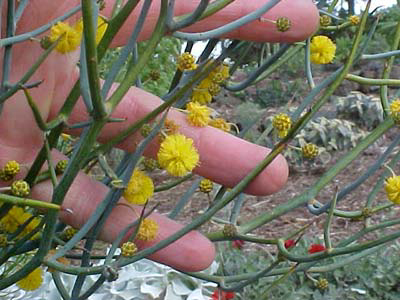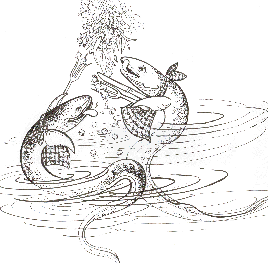
Around the world, Indigenous peoples make great use of acacias. In Somalia for example, some peoples base much of their domestic economy for themselves and their animals on acacias. Acacias provide them with forage for their stock, frame timber for portable dwellings, for fencing, charcoal, rope and gums.
In Australia, the Aboriginal peoples always had a use for their local species and all parts of the plants were used, the foliage, bark, wood, gum, flowers, pods, seeds, roots, even insects that live on the acacias were used.
Here are some of the Wattle uses of traditional Australian aborigines:
- seeds for food
- pods for food and soap
- foliage for medicinal purposes
- bark for infusions, bandages, ropes and footware
- gums for eating, glue and medicinal purposes
- wood for weapons, implements and fires
- roots and trunks of plants as homes of edible grubs
- ash for mixing with tobacco
 Great
tracts of land are now known by the Aboriginal names for the Wattles
that grow there - Myall (Acacia pendula), Mulga (Acacia aneura),
Brigalow (Acacia harpophylla) and Gidgee (Acacia cambagei).
Wattle wood is very hard, and many a good boomerang has come from a
wattle. Wattles produce edible seeds and nutritious flour can be made
from the crushed seeds of several species. Shields, digging sticks,
spear throwers, fuel, gum, medicines, musical instruments - Aboriginal
people had many uses for wattles. Grubs, a popular food item, can be
found in many wattles. The Witchetty Grub for example lives in the roots
of Acacia kempeana, which is why it is called the Witchetty Bush.
On average there are three grubs in each root and in good years there
can be as many as 50 found on each plant of Acacia kempeana.
Witchetty Grubs can grow as large as a person's thumb and have a flavour
somehwer between egg yolk and almonds. In some other Wattles, Acacia
craspedocarpa (Hop Mulga) for example, the green pods were eaten
as a sort of snack food, picked directly from the plants.
Great
tracts of land are now known by the Aboriginal names for the Wattles
that grow there - Myall (Acacia pendula), Mulga (Acacia aneura),
Brigalow (Acacia harpophylla) and Gidgee (Acacia cambagei).
Wattle wood is very hard, and many a good boomerang has come from a
wattle. Wattles produce edible seeds and nutritious flour can be made
from the crushed seeds of several species. Shields, digging sticks,
spear throwers, fuel, gum, medicines, musical instruments - Aboriginal
people had many uses for wattles. Grubs, a popular food item, can be
found in many wattles. The Witchetty Grub for example lives in the roots
of Acacia kempeana, which is why it is called the Witchetty Bush.
On average there are three grubs in each root and in good years there
can be as many as 50 found on each plant of Acacia kempeana.
Witchetty Grubs can grow as large as a person's thumb and have a flavour
somehwer between egg yolk and almonds. In some other Wattles, Acacia
craspedocarpa (Hop Mulga) for example, the green pods were eaten
as a sort of snack food, picked directly from the plants.
In the Yarra Valley around Melbourne the Silver Wattle (Acacia dealbata) grows. Muyan, this wattle, likes living near river banks. One Melbourne Aboriginal community, the Wurundjeri people hold great symbolism for the muyan - the wattle. As for two centuries now it is known that their greatest Elders have all 'passed over' when the wattle blooms. It also means eel season. In Aboriginal culture, plants are not just utilised as food, medicine or implements. The seasonal changes in a plant's development are read as indicators. When the wattle flowers fall it is time to fish for eels. Wattle blossoms will coat the slow moving Yarra at this time. Eels feed on a particular grub that lives in the wattle flowers. This feeding is part of the eels preparing for the autumn migrations, and a good time to catch a well fed eel! The muyan is also used to symbolise Elders. It is a plant where every part is used - blossoms, gum, seed, bark and wood. It keeps the community strong, alive and healthy just as the Elders with their wisdom and experience.
Wattle you know wattle you do?
- How are boomerangs made and with what wood?
- Type boomerang into a search engine and see what comes back!
- Research reading of the seasons by Aboriginal Peoples: http://www.museum.vic.gov.au/forest/ and www.gould.edu.au